Angel of the North
The Angel of the North is a contemporary sculpture, designed by Antony Gormley, located in Gateshead, Tyne and Wear, England.
| Angel of the North | |
|---|---|
 The Angel of the North, October 2014 | |
 Location within Tyne and Wear | |
| General information | |
| Type | Artwork |
| Location | Low Eighton, Gateshead, NE9 United Kingdom NE9 7TY |
| Coordinates | 54.915°N 1.59°W |
| Elevation | 75 metres (246.1 ft) |
| Construction started | 1994 |
| Completed | 1998 |
| Height | 20 metres (65.6 ft) |
| Design and construction | |
| Architect | Antony Gormley (artist) |
| Structural engineer | Ove Arup |
| Main contractor | Hartlepool Steel Fabrications |
Completed in 1998, it is a steel sculpture of an angel, 20 metres (66 ft) tall, with wings measuring 54 metres (177 ft) across.[1] The wings are angled 3.5 degrees forward to create, according to Gormley, "a sense of embrace".[2] The angel, like much of Gormley's other work, is based on a cast of his own body.[3]
It stands on a hill at Low Eighton in Lamesley parish, overlooking the A1 and A167 roads and the East Coast Main Line rail route, south of the site of Team Colliery.[4]
Concept
According to Gormley, the significance of an angel was three-fold: firstly, to signify that beneath the site of its construction, coal miners worked for two centuries; secondly, to grasp the transition from an industrial to an information age; and thirdly, to serve as a focus for our evolving hopes and fears.[2]
Construction
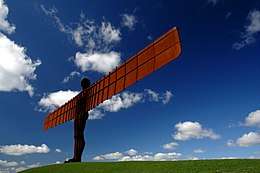
Work began on the project in 1994.[5] Gateshead Council secured funding of £800,000 - £584,000 from the Arts Council England, £150,000 from the European Regional Development Fund, £45,000 from Northern Arts, plus private sponsorship.[6] The Angel was installed on 15 February 1998.[7]
Due to its exposed location, the sculpture was built to withstand winds of over 100 mph (160 km/h). Thus, foundations containing 600 tonnes (590 long tons; 660 short tons) of concrete anchor the sculpture to rock 70 feet (21 m) below. The sculpture was built at Hartlepool Steel Fabrications Ltd using COR-TEN weather-resistant steel.
It was made in three parts—with the body weighing 100 tonnes (98 long tons; 110 short tons) and two wings weighing 50 tonnes (49 long tons; 55 short tons) each—then brought to its site by road. The components were transported in convoy—the body on a 48-wheel trailer—from their construction site in Hartlepool, up the A19 road to the installation site 28 miles (45 km) away; the nighttime journey took five hours and attracted large crowds.[7][8]
The plaque beside the angel reads "The hill top site is important and has the feeling of being a megalithic mound. "When you think of the mining that was done underneath the site, there is a poetic resonance. Men worked beneath the surface in the dark.... It is important to me that the Angel is rooted in the ground—the complete antithesis of what an angel is, floating about in the ether. It has an air of mystery. You make things because they cannot be said."[9] This writing pays homage to the central idea of the statue to represent the past, present, and the changing times of the nation.
Maquettes
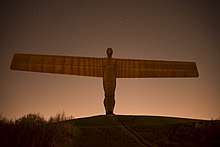
Several maquettes were produced during the development stage of the project.[10] A life-size model from which the sculpture was created was sold at auction for £2.28 million in July 2008.[11] An additional bronze maquette used in fundraising in the 1990s, owned by Gateshead Council, was valued at £1 million on the BBC show Antiques Roadshow on 16 November 2008—the most valuable item ever appraised on the programme.[10][12]
In 2011 German fashion designer Wolfgang Joop sold his life-size maquette (previously kept in the garden of his mansion in Potsdam, Germany) at an auction at Christie's in London for £3.4 million to an anonymous bidder.[13][14] Another maquette was donated to the National Gallery of Australia in 2009, and stands in its Sculpture Garden.[15]
Other projects
Inspired by the Angel of the North, several similar projects have been proposed. The Angel of the South title has been given by some to the Willow Man, which sits to the side of the M5 in Somerset, while the White Horse at Ebbsfleet has been proposed for Ebbsfleet Valley, Kent. The sculpture Brick Man (also by Gormley) was proposed for the Holbeck area of Leeds.
Controversies
Site
There were comments made about potential for car accidents resulting from the statue's position next to the A1.[8] Trees have now been allowed to grow up to hide the sculpture from the road at the point where it passes closest. There were also concerns over interference to TV reception.[8]
Design
The Gateshead Post drew comparisons between the Angel and a 1930s Nazi statue.[8]
Pre-construction opposition
The Angel aroused some controversy in British newspapers, at first, including a "Gateshead stop the statue" campaign, Initially Gormley by his own account had been "snooty" towards the project.[8] When the council originally invited Gormley to present his ideas, he scoffed at the opportunity saying that he "did not make motorway art".[16] Liberal Democrat councillor Jonathan Wallace, who opposed constructing the statue missed the decisive council vote having taken a new job.[8] Despite any early opposition The Angel is now considered to be a landmark for North East England.[7][17]
The Angel has been listed by one organisation as an "Icon of England".[18] The Guardian National newspaper also cited that the sculpture is also humorously known by some local people as the "Gateshead Flasher", because of its location and appearance.[19] no local reference to this term can be found.
Morrisons supermarket
On 7 May 2014 the supermarket Morrisons projected a large baguette onto the Angel, an act Gormley called "shocking and stupid".[20] The company issued a statement saying, "We're sorry if you thought we got carried away by shining a baguette on the Angel of the North and apologise unreservedly to those to whom we have caused offence".[20]
Tourism Ireland
In 2011 Gateshead Council refused Tourism Ireland permission to illuminate the Angel for St Patrick's day.[20]
Gallery
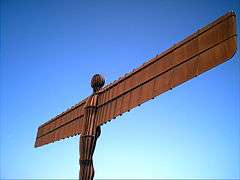
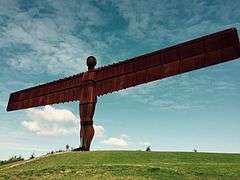
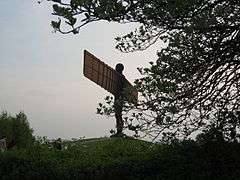
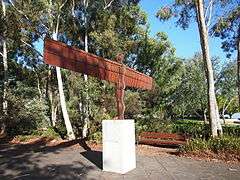 Rear view of Angel of the North (man-size maquette) at the National Gallery of Australia
Rear view of Angel of the North (man-size maquette) at the National Gallery of Australia- A Lego model of Angel of the North in Miniland
See also
- Angel of the West
- List of statues by height
- Star of Caledonia
- Wicker man
References
- "Facts". Gateshead.gov.uk. Archived from the original on 27 October 2011. Retrieved 18 October 2010.
- "The Angel of the North > Background". Gateshead Council. Archived from the original on 29 March 2007. Retrieved 9 March 2007.
Gormley said of the Angel: '...The effect of the piece is in the alertness, the awareness of space and the gesture of the wings – they are not flat, they're about 3.5 degrees forward and give a sense of embrace.'
- https://www.britannica.com/biography/Antony-Gormley
- Durham Mining Museum. "Durham Mining Museum – 1951 Durham Map 23". Dmm-gallery.org.uk. Retrieved 18 October 2010.
- "Angel facts". Gateshead council. 16 February 1998. Archived from the original on 27 October 2011. Retrieved 16 June 2015.
- "Angel of the North celebrates 20th birthday". Gateshead council. 15 February 2018. Retrieved 10 July 2019.
- "The angel has landed". BBC News. 16 February 1998. Retrieved 9 March 2007.
- Williams, Francesca (11 February 2018). "Angel of the North: The icon that was nearly never built". BBC. Retrieved 14 February 2018.
- Langland, Tuck. “Angel of the North: An Icon for Great Britain?” SCULPTURE REVIEW, vol. 61, no. 3, pp. 30–35. EBSCOhost, login.proxy006.nclive.org/login?url=http://search.ebscohost.com/login.aspx?direct=true&db=edswah&AN=000310925200003&site=eds-live&scope=site. Accessed 27 Mar. 2019.
- "Angel of the north is one in a million". Gateshead Council. 17 November 2008. Retrieved 19 November 2008.
- "Buyer pays £2.3m for Angel model". BBC News. 2 July 2008. Retrieved 4 October 2015.
- "Antiques Roadshow finds £1m Angel". BBC News. 16 November 2008. Retrieved 1 January 2010.
- "Joop lets his angel fly". Bild. 23 October 2011. Retrieved 25 August 2015.
- "Antony Gormley's 'Angel of North' sold at auction". BBC. 15 October 2011. Retrieved 25 August 2015.
- "Angel of the North (life-size maquette) 1996". Collection search. National Gallery of Australia. Retrieved 6 January 2013.
- Williams, Francesca. "Angel of the North: The Icon That Was Nearly Never Built." BBC News. 11 February 2018, www.bbc.com/news/uk-england-tyne-42426028.
- "Angel of the North". AboutBritain.com. Archived from the original on 4 April 2007. Retrieved 9 March 2007.
- "Icons of England". Icons.org.uk. Archived from the original on 28 July 2017. Retrieved 18 October 2010.|url-status=dead
- Higgins, Charlotte (27 September 2010). "Antony Gormley". The Guardian. London. Archived from the original on 30 August 2010. Retrieved 28 September 2010.
- "Antony Gormley describes Morrison's Angel of the North stunt as 'shocking and stupid'; The supermarket apologised for projecting a baguette onto the Angel's wings after it caused widespread outrage". Telegraph Online. 7 May 2014. Retrieved 31 March 2019.
External links
| Wikimedia Commons has media related to Angel of the North. |
- Gateshead Council's Angel of the North website
- Angel of the North – Antony Gormley's official website
- The Angel of the North at icons.org, featuring pictures of the sculpture under construction
- "In praise of ... the Angel of the North". The Guardian. London. 30 January 2008. Archived from the original on 31 January 2008. Retrieved 7 February 2008.
- Photo showing a maquette in the garden of German fashion designer Wolfgang Joop's mansion 'Villa Wunderkind' in Potsdam, Germany